
EFE 32201 Bristol/ECW RELH Coach - United
Automobile Services
Released September 2006
Review by Andrew Glasse
After what for me has been a wait of many
years, one of the two model coaches I have been dreaming about has come
on the market from EFE, and has even been given the accolade of Showbus
Model 2006. An honour indeed for a vehicle which represented the best
United had to offer during the late sixties, and which was widely
represented throughout England and Wales. The word grace cannot easily
“grace” a coach body, but ECW in Lowestoft built a body which not only
looked graceful, it was also simple in lines and lent itself to
modification in a number of ways, some more successful than others. It
also wore many different liveries equally well, something which cannot
be said of many of today’s artistic efforts in coach design.
At the time, the Bristol RELH (Rear Engine Long High) with a six
cylinder Gardner rated at 150 bhp, was regarded as a comfortable
long-distance coach which was also a good drive after semi-automatic
transmission was introduced in March of 1967. Today, we can smile at the
almost comical low power-rating, and it’s true, a fully loaded coach
would need to change down on the climb from the A1 up to Junction 32 on
the M1, but this was more than mitigated by the smooth sound of the
engine and the whine of the transmission. Normal speed on the motorway
was between 50 and 60 miles an hour, although rumour had it that certain
manual gear-box versions could do over 80 if pushed. 1236 was reputed to
be a fast mover. I cannot confirm this. These coaches were a pleasure at
the time, and a pleasure to remember today, some thirty five years after
I ceased enjoying them, moving to the land of the Scania and the Volvo
and Vestfold Bil og Karosserifabrikk in Norway!
semi-automatic
transmission was introduced in March of 1967. Today, we can smile at the
almost comical low power-rating, and it’s true, a fully loaded coach
would need to change down on the climb from the A1 up to Junction 32 on
the M1, but this was more than mitigated by the smooth sound of the
engine and the whine of the transmission. Normal speed on the motorway
was between 50 and 60 miles an hour, although rumour had it that certain
manual gear-box versions could do over 80 if pushed. 1236 was reputed to
be a fast mover. I cannot confirm this. These coaches were a pleasure at
the time, and a pleasure to remember today, some thirty five years after
I ceased enjoying them, moving to the land of the Scania and the Volvo
and Vestfold Bil og Karosserifabrikk in Norway!
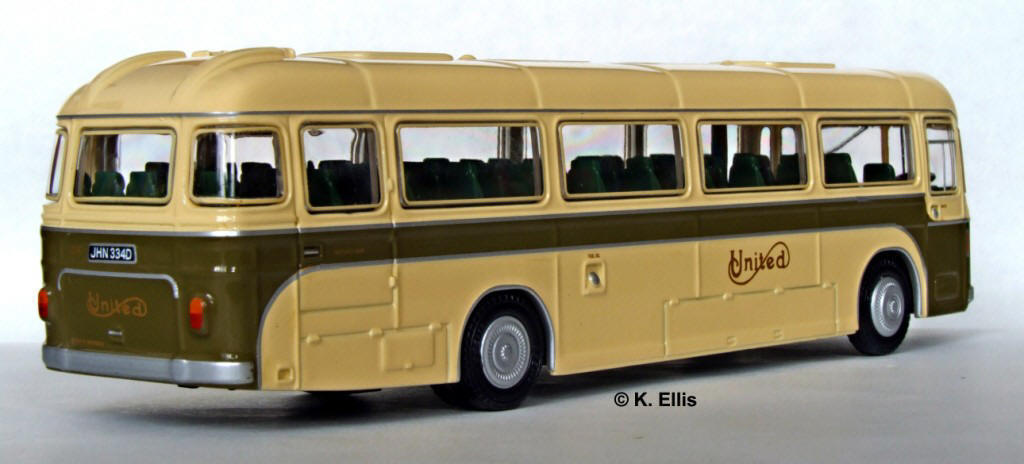 The chassis came in two versions, Series 1 and Series 2, The difference
was primarily one of length, the first series having a 19’ wheel-base,
whereas the later version which appeared in April 1967 as an isolated
case, but took over all new production in January 1968, was six inches
shorter between axles, allowing for a tighter lock. Another difference,
crucial to the immaculate ride, was a change from air suspension to
leaf-spring suspension, or as Duncan Roberts so aptly describes it,
“cart-spring suspension”. This made the product marginally cheaper to
buy, but the smooth nature of the ride disappeared and wear and tear on
the chassis and body was to cost more in the long run. The
Leyland/Bristol relationship is to blame for much of this, but politics
of the early seventies is outside the remit of this review.
The chassis came in two versions, Series 1 and Series 2, The difference
was primarily one of length, the first series having a 19’ wheel-base,
whereas the later version which appeared in April 1967 as an isolated
case, but took over all new production in January 1968, was six inches
shorter between axles, allowing for a tighter lock. Another difference,
crucial to the immaculate ride, was a change from air suspension to
leaf-spring suspension, or as Duncan Roberts so aptly describes it,
“cart-spring suspension”. This made the product marginally cheaper to
buy, but the smooth nature of the ride disappeared and wear and tear on
the chassis and body was to cost more in the long run. The
Leyland/Bristol relationship is to blame for much of this, but politics
of the early seventies is outside the remit of this review.
The model we have in front of us has already been well previewed
elsewhere. Some excellent photographs taken at Duxford clearly show that
EFE are true to their production traditions. We have a heavy diecast
model with all the advantages and drawbacks this model form contains.
The question I want to ask myself is, “Does this model embody what I
knew and remember about United’s REs?” As a collector and modeller with
expertise on ships in 1:1250, I believe there are two factors involved:
firstly, the sum of all the details, which make up the general overall
impression. You know what I mean, plenty of intricate detail can be
fine, but useless if the general impression is wrong. On the other hand,
detail is not so easy to spot at a distance, especially with my
middle-aged eyesight, but the general shape and colour is, thus making
it a vital factor in an evaluation. Generally then, I feel this model
fulfils its function for me as being a good representation of a coach I
had a fair amount of contact with and remember fondly. Why?
I would like to start by giving my opinion of general impressions. The
EFE model is good. The body looks heavy, but the EFE casting technique
and thick layers of paint make this unavoidable and it is fine in any
case. There is a problem with the front dome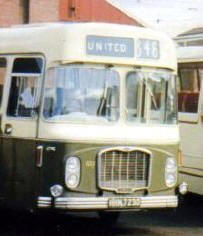
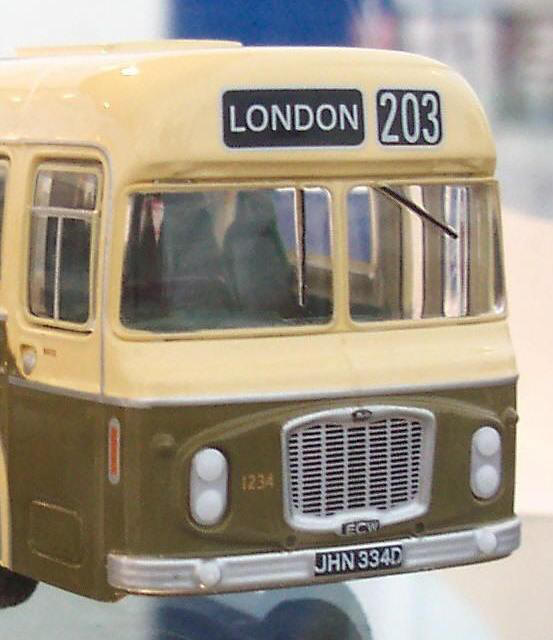 , which is too rounded at
the corners and this is accentuated by the corner of the blind frame
bending away slightly. On versions such as Royal Blue, this will not be
a problem, of course. Otherwise, the body seems excellent and a true
1:76 likeness of the real thing. Even though the all-plastic windscreen
has a painted middle pillar, I accept this compromise. Colour is as
correct as I can tell, not knowing the colour codes that were used by
ECW. Light conditions would make olive green look like anything from
green to brown anyway, and cream can look ivory or almost buff so the
model is good enough. Everything seems to be there, but it is on
examining the detail that I begin to feel an itch in my fingers and a
need to plan some alterations!
, which is too rounded at
the corners and this is accentuated by the corner of the blind frame
bending away slightly. On versions such as Royal Blue, this will not be
a problem, of course. Otherwise, the body seems excellent and a true
1:76 likeness of the real thing. Even though the all-plastic windscreen
has a painted middle pillar, I accept this compromise. Colour is as
correct as I can tell, not knowing the colour codes that were used by
ECW. Light conditions would make olive green look like anything from
green to brown anyway, and cream can look ivory or almost buff so the
model is good enough. Everything seems to be there, but it is on
examining the detail that I begin to feel an itch in my fingers and a
need to plan some alterations!
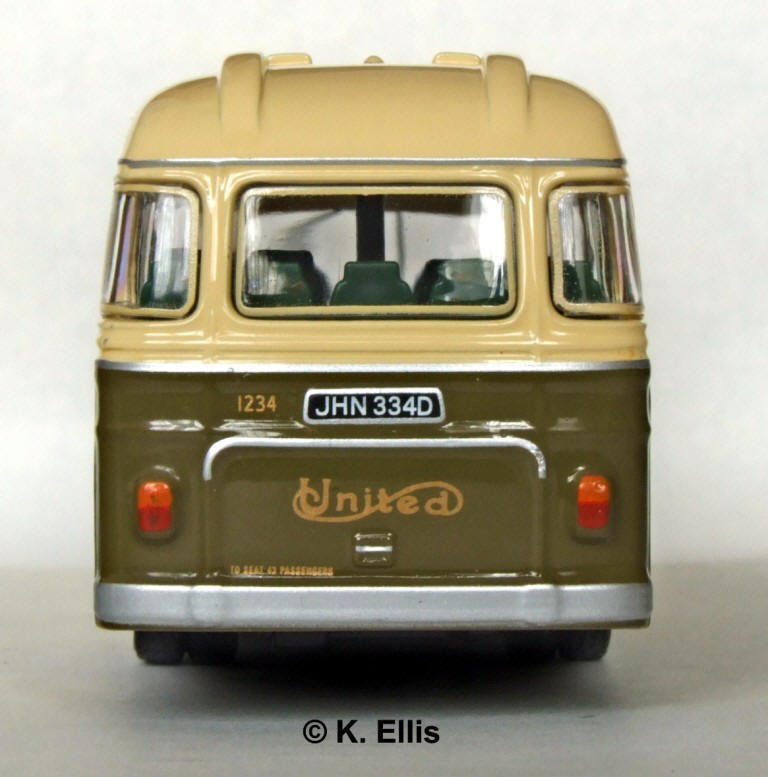 What is the model purporting to be? It is registered as JHN334D, fleet
number 1234. This is a Series 1 vehicle registered in May of 1966 and
modelled as was after the 1st of January, 1969. It thus had a
long wheelbase, air suspension and manual gearbox. The curve over the
model’s front wheel reveals that this point has not been taken on board
by the painter of the model. United were alone in this livery type. The
curve remained the same on both series, meaning that a six inch
cream-coloured gap between wheel arch and bulkhead was visible on Series
2 vehicles due to the front axle being moved six inches back. This is
seen clearly on the model and is an important error in my view, one
which I will correct, either by repainting, or more simply, by
renumbering the coach. It doesn’t matter with all the other liveries;
the parallel beading and bright work ran the full length of the coach.
What is the model purporting to be? It is registered as JHN334D, fleet
number 1234. This is a Series 1 vehicle registered in May of 1966 and
modelled as was after the 1st of January, 1969. It thus had a
long wheelbase, air suspension and manual gearbox. The curve over the
model’s front wheel reveals that this point has not been taken on board
by the painter of the model. United were alone in this livery type. The
curve remained the same on both series, meaning that a six inch
cream-coloured gap between wheel arch and bulkhead was visible on Series
2 vehicles due to the front axle being moved six inches back. This is
seen clearly on the model and is an important error in my view, one
which I will correct, either by repainting, or more simply, by
renumbering the coach. It doesn’t matter with all the other liveries;
the parallel beading and bright work ran the full length of the coach.
The windows and skylights are also a worry. EFE demonstrates with this
model that pressed Perspex or plastic glazing is a problem. The Corgi
Fife Lodekka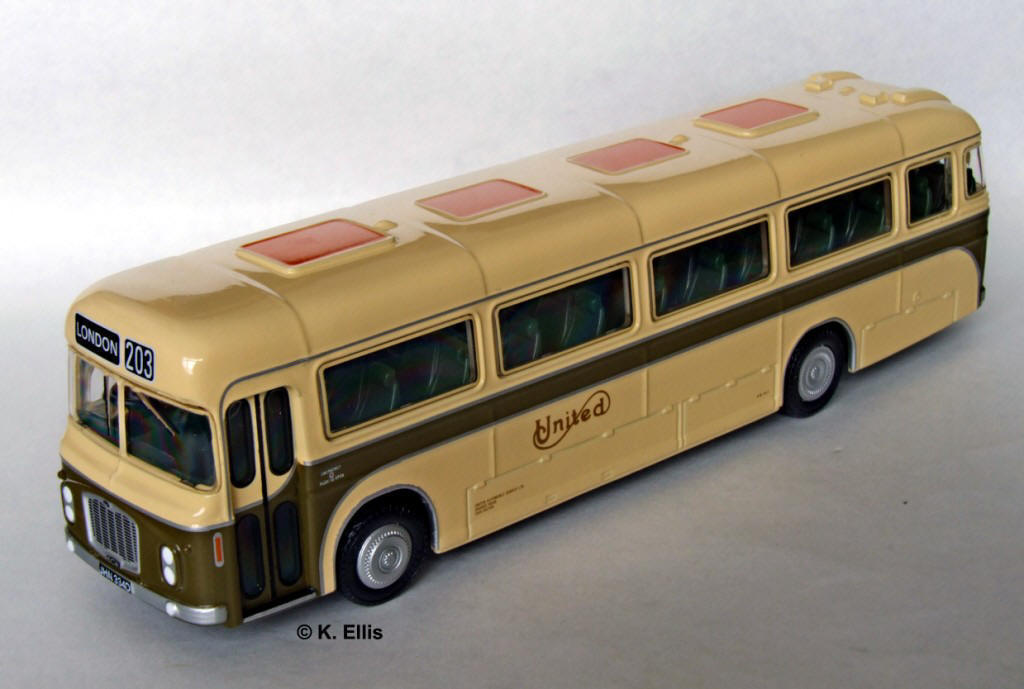 is a similar case in point and the RELH suffers from this
same mistake in detail. These coaches had cream rubbers round the
windows, (all the windows, including in the doors). EFE have painted
this cream on the ridge of glazing around the window and not on the
metal frame where it belongs. This makes the windows too small and the
pillars too fat and is especially disturbing to the appearance of the
model when it is looked at from a three-quarters aft position. This will
be even more apparent on the Royal Blue version, for obvious reasons.
The four skylights are in fact painted onto the metal. This is a cheap
disappointment, and pushes the model very slightly in the direction of
being a toy. What a pity that these could not have been glazed. They
were in two colours, by the way. The larger front and back skylights
could be opened and were glazed a creamy colour, while the middle two
were fixed and had a bathroom window type grey/white glazing.
is a similar case in point and the RELH suffers from this
same mistake in detail. These coaches had cream rubbers round the
windows, (all the windows, including in the doors). EFE have painted
this cream on the ridge of glazing around the window and not on the
metal frame where it belongs. This makes the windows too small and the
pillars too fat and is especially disturbing to the appearance of the
model when it is looked at from a three-quarters aft position. This will
be even more apparent on the Royal Blue version, for obvious reasons.
The four skylights are in fact painted onto the metal. This is a cheap
disappointment, and pushes the model very slightly in the direction of
being a toy. What a pity that these could not have been glazed. They
were in two colours, by the way. The larger front and back skylights
could be opened and were glazed a creamy colour, while the middle two
were fixed and had a bathroom window type grey/white glazing.
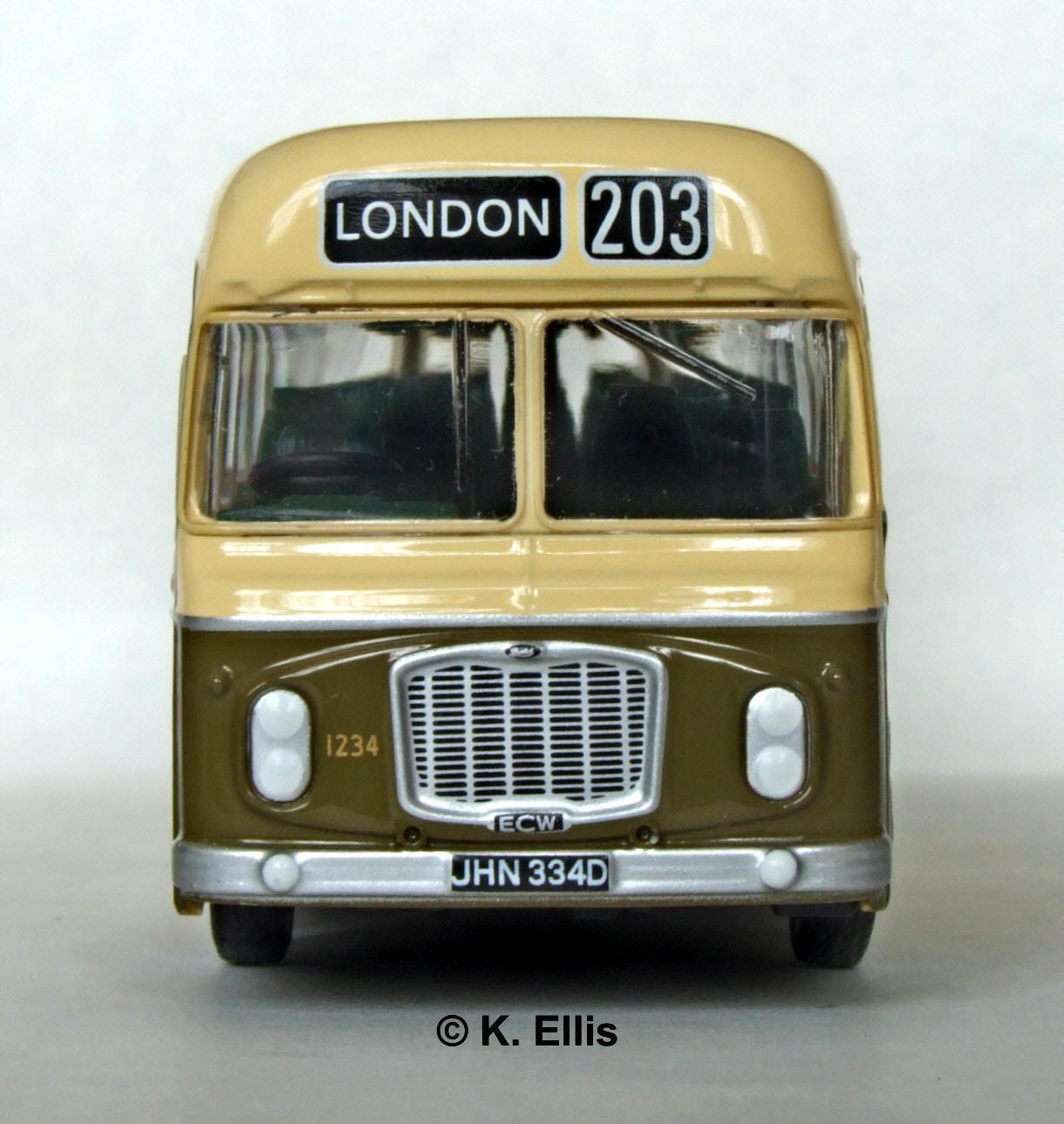 Other details are both good, almost excellent, and some are simply
wrong. The fog lamps which are painted in white on the front bumper were
in reality raised over the bumper outside the main body-mounted light
clusters. The really good, detailed riveting in the wheel arches and the
beautifully profiled tyres make the pimples on the front of the model
look trivial. These were in fact side lights. The indicators are printed
on, and are just begging to be modified with a piece of white
polystyrene and some amber paint! Finally, the air intakes over the
windscreen are in sore need of sharper definition and reveal the
greatest weakness in EFE’s casting techniques. I feel it should be
possible to show the holes, and make a better job of recreating the
shape of the housing as well as the sharp edge under the destination
dome. I don’t think I am expecting too much.
Other details are both good, almost excellent, and some are simply
wrong. The fog lamps which are painted in white on the front bumper were
in reality raised over the bumper outside the main body-mounted light
clusters. The really good, detailed riveting in the wheel arches and the
beautifully profiled tyres make the pimples on the front of the model
look trivial. These were in fact side lights. The indicators are printed
on, and are just begging to be modified with a piece of white
polystyrene and some amber paint! Finally, the air intakes over the
windscreen are in sore need of sharper definition and reveal the
greatest weakness in EFE’s casting techniques. I feel it should be
possible to show the holes, and make a better job of recreating the
shape of the housing as well as the sharp edge under the destination
dome. I don’t think I am expecting too much.
There is more, mostly positive although some negative. Printing of
detail is excellent, but occasionally in the wrong position or slightly
wrong in size. I know that a great deal of documentation is required in
the production of a model like this. This documentation is available,
both in the form of literature and pictures, and not least with the
people who knew these vehicles. The compromise necessary in producing
models should not negate documentary evidence and spoil a model. I don’t
think this has happened in the case of EFE’s RELH to any decisive
extent, but some of the mistakes I mention here seem somewhat slapdash
and do detract from the final verdict.
The model is priced at a reasonable level in my view, although Norwegian
spending power may perhaps still be slightly greater than British. I
feel I am getting what I am paying for and have no complaints. I am very
grateful the model has arrived at long last and intend collecting it in
every livery that becomes available. By the way, I am not a collector of
models for their investment value, and fully intend to modify and
improve detail where I can. Mirrors, wipers, extra fog lamps and raised
bright work would make the model more expensive had EFE gone to the
trouble of doing it, but I intend adding them as soon as possible. This
will probably destroy the model in many people’s eyes. Not in mine. It
is an excellent base on which to work and I look forward to seeing the
result!
AG
And I almost forgot to mention that the other model is the Alexander M.
The opinions offered in the reviews on this page remain those of the author, and do not necessarily represent the of views of The Model Bus Website.